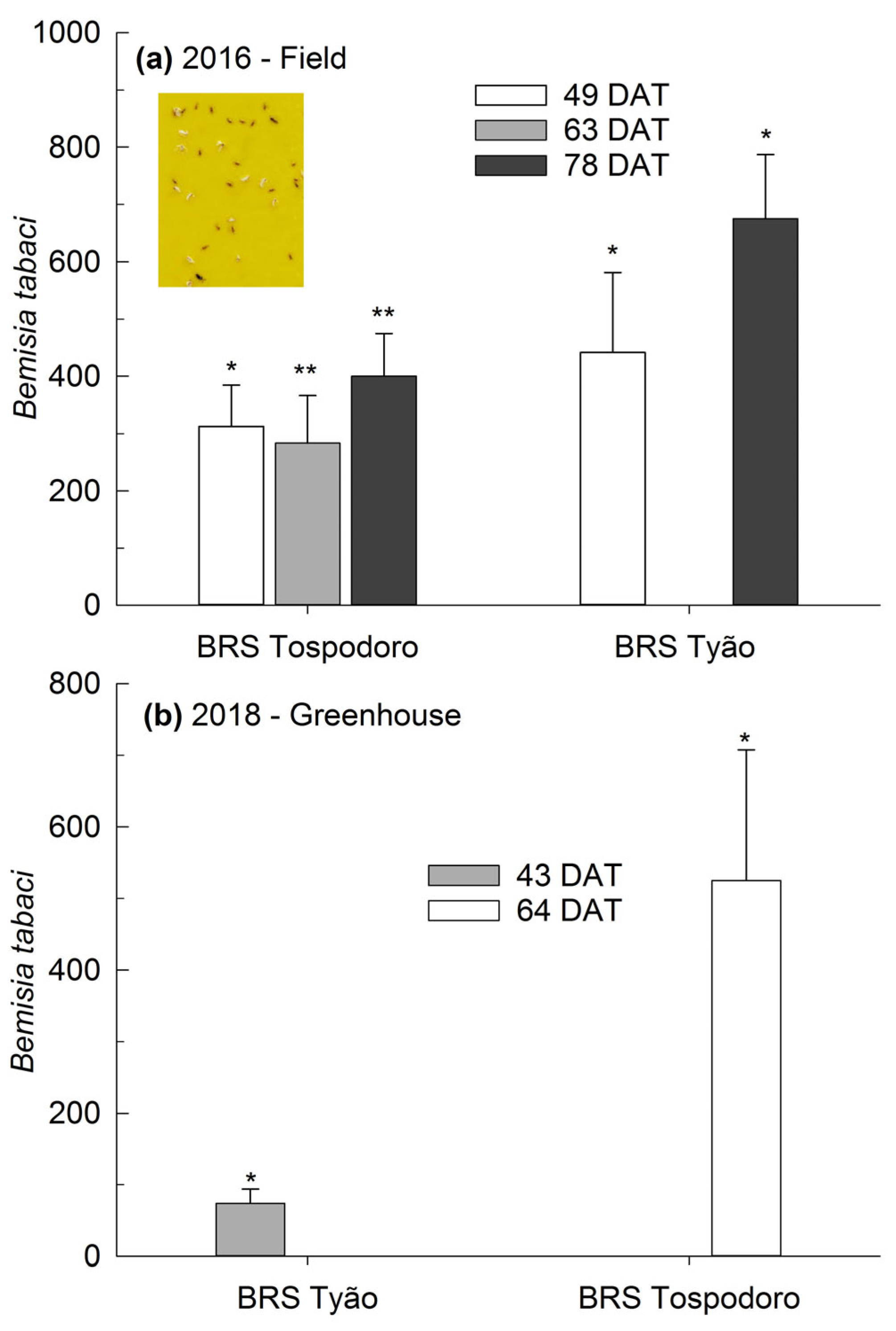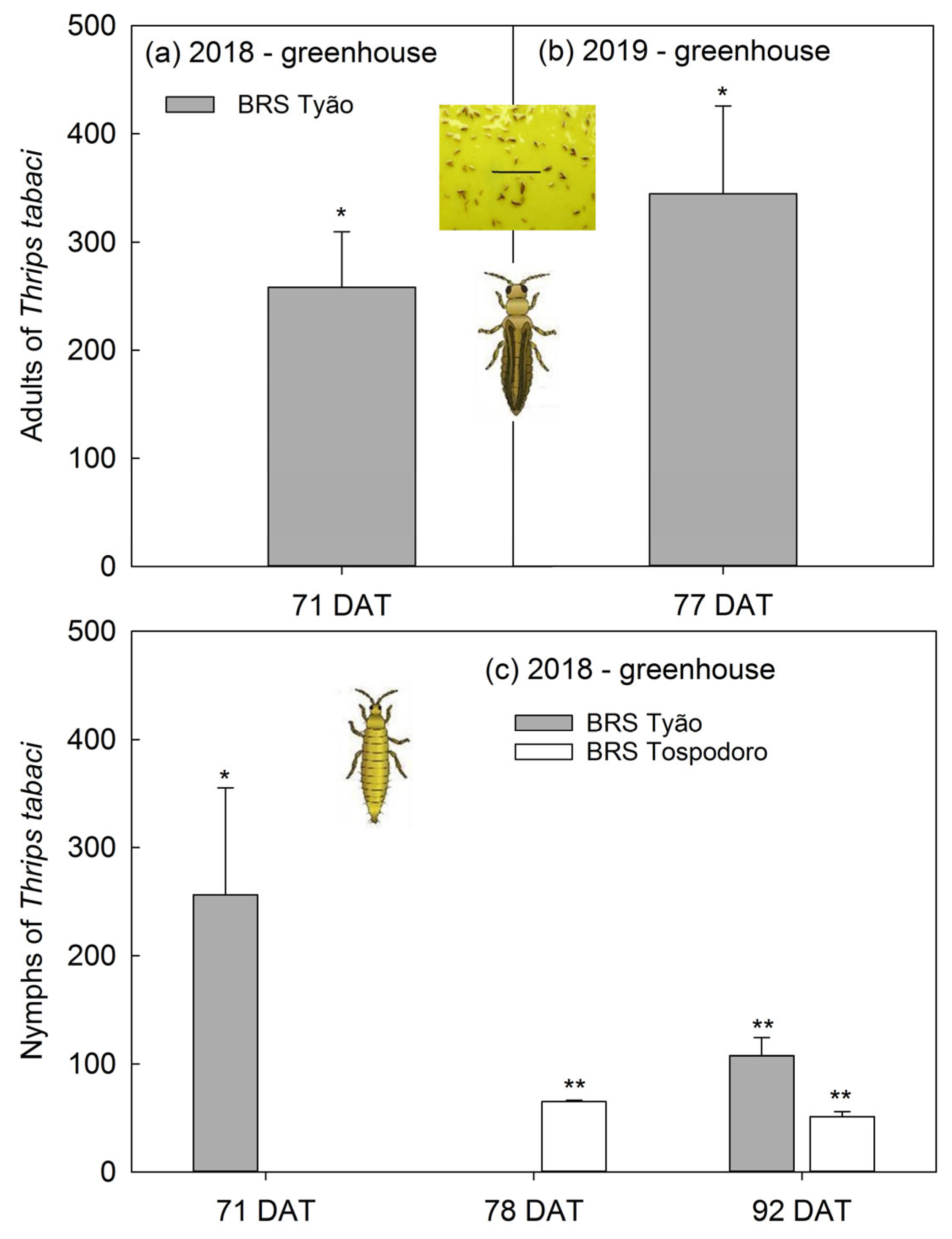Associational Resistance Using Wild and Commercial Tomato Genotypes Employed in the Management of Tomato Virus Vectors
Abstract
:1. Introduction
2. Materials and Methods
2.1. General Conditions
2.2. Field Trials
2.2.1. Surveys
2.2.2. Traps
2.2.3. Fruit Evaluation
2.3. Greenhouse Trials
2.3.1. Surveys
2.3.2. Insects Caught on Traps
2.3.3. Fruit Evaluation
2.4. Data Analysis
3. Results
4. Discussion
5. Conclusions
Author Contributions
Funding
Institutional Review Board Statement
Data Availability Statement
Acknowledgments
Conflicts of Interest
References
- Abewoy Fentik, D. Review on Genetics and Breeding of Tomato (Lycopersicon esculentum Mill). Adv. Crop Sci. Technol. 2017, 5, 306. [Google Scholar] [CrossRef]
- Costa, J.M.; Heuvelink, E. The Global Tomato Industry. In Tomatoes; Heuvelink, E., Ed.; CABI: Wallingford, UK, 2018; pp. 1–26. ISBN 978-1-78064-193-5. [Google Scholar]
- Li, Y.; Mbata, G.N.; Punnuri, S.; Simmons, A.M.; Shapiro-Ilan, D.I. Bemisia tabaci on Vegetables in the Southern United States: Incidence, Impact, and Management. Insects 2021, 12, 198. [Google Scholar] [CrossRef]
- Ali, J. The Peach Potato Aphid (Myzus Persicae): Ecology and Management; CRC Press: Boca Raton, FL, USA, 2023; ISBN 1-00-099677-8. [Google Scholar]
- Loredo Varela, R.C.; Fail, J. Host Plant Association and Distribution of the Onion Thrips, Thrips tabaci Cryptic Species Complex. Insects 2022, 13, 298. [Google Scholar] [CrossRef] [PubMed]
- Castañé, C.; Van Der Blom, J.; Nicot, P.C. Tomatoes. In Integrated Pest and Disease Management in Greenhouse Crops; Gullino, M.L., Albajes, R., Nicot, P.C., Eds.; Springer International Publishing: Cham, Switzerland, 2020; pp. 487–511. ISBN 978-3-030-22303-8. [Google Scholar]
- Ong, S.N.; Taheri, S.; Othman, R.Y.; Teo, C.H. Viral Disease of Tomato Crops (Solanum lycopersicum L.): An Overview. J. Plant Dis. Prot. 2020, 127, 725–739. [Google Scholar] [CrossRef]
- Võ, T.T.; Dehne, H.-W.; Hamacher, J. Transmission of Tomato Chlorotic Dwarf Viroid by Myzus persicae Assisted by Potato Leafroll Virus. J. Plant Dis. Prot. 2018, 125, 259–266. [Google Scholar] [CrossRef]
- Roditakis, E.; Stavrakaki, M.; Grispou, M.; Achimastou, A.; Van Waetermeulen, X.; Nauen, R.; Tsagkarakou, A. Flupyradifurone Effectively Manages Whitefly Bemisia tabaci MED (Hemiptera: Aleyrodidae) and Tomato Yellow Leaf Curl Virus in Tomato. Pest Manag. Sci. 2017, 73, 1574–1584. [Google Scholar] [CrossRef]
- Dudley, N.; Attwood, S.J.; Goulson, D.; Jarvis, D.; Bharucha, Z.P.; Pretty, J. How Should Conservationists Respond to Pesticides as a Driver of Biodiversity Loss in Agroecosystems? Biol. Conserv. 2017, 209, 449–453. [Google Scholar] [CrossRef]
- Barratt, B.I.P.; Moran, V.C.; Bigler, F.; Van Lenteren, J.C. The Status of Biological Control and Recommendations for Improving Uptake for the Future. BioControl 2018, 63, 155–167. [Google Scholar] [CrossRef]
- Balabanidou, V.; Grigoraki, L.; Vontas, J. Insect Cuticle: A Critical Determinant of Insecticide Resistance. Curr. Opin. Insect Sci. 2018, 27, 68–74. [Google Scholar] [CrossRef]
- Sarwar, M. Insects as Transport Devices of Plant Viruses. In Applied Plant Virology; Elsevier: Amsterdam, The Netherlands, 2020; pp. 381–402. ISBN 978-0-12-818654-1. [Google Scholar]
- Stout, M.J.; Kurabchew, H.; Leite, G.L.D. Host-Plant Resistance in Tomato. In Sustainable Management of Arthropod Pests of Tomato; Elsevier: Amsterdam, The Netherlands, 2018; pp. 217–236. ISBN 978-0-12-802441-6. [Google Scholar]
- Bastos, C.S.; Ribeiro, A.V.; Suinaga, F.A.; Brito, S.M.; Oliveira, A.A.; Barbosa, T.M.; dos Santos, P.D.; Oliveira, D.V.; Teichmann, Y.S. Resistência de Plantas a Insetos: Contextualização e Inserção No MIP. In Avanços Tecnológicos Aplicados à Pesquisa na Produção Vegetal; Universidade Federal de Viçosa: Viçosa, Brazil, 2015; pp. 31–72. [Google Scholar]
- Pickett, J.A.; Woodcock, C.M.; Midega, C.A.; Khan, Z.R. Push–Pull Farming Systems. Curr. Opin. Biotechnol. 2014, 26, 125–132. [Google Scholar] [CrossRef]
- Cook, S.M.; Khan, Z.R.; Pickett, J.A. The Use of Push-Pull Strategies in Integrated Pest Management. Annu. Rev. Entomol. 2007, 52, 375–400. [Google Scholar] [CrossRef] [PubMed]
- Antonious, G.; Snyder, J. Natural Products: Repellency and Toxicity of Wild Tomato Leaf Extracts to the Two-Spotted Spider Mite, Tetranychus urticae Koch. J. Environ. Sci. Health Part B 2006, 41, 43–55. [Google Scholar] [CrossRef] [PubMed]
- Lucatti, A.F.; Meijer-Dekens, F.R.; Mumm, R.; Visser, R.G.; Vosman, B.; Van Heusden, S. Normal Adult Survival but Reduced Bemisia Tabaci Oviposition Rate on Tomato Lines Carrying an Introgression from S. habrochaites. BMC Genet. 2014, 15, 142. [Google Scholar] [CrossRef] [PubMed]
- Conboy, N.J.A.; McDaniel, T.; Ormerod, A.; George, D.; Gatehouse, A.M.R.; Wharton, E.; Donohoe, P.; Curtis, R.; Tosh, C.R. Companion Planting with French Marigolds Protects Tomato Plants from Glasshouse Whiteflies through the Emission of Airborne Limonene. PLoS ONE 2019, 14, e0213071. [Google Scholar] [CrossRef] [PubMed]
- SAS. SAS System, Version 9.1. 3; SAS Institute Inc.: Cary, NC, USA, 2008. [Google Scholar]
- Mutschler, M.A.; Doerge, R.W.; Liu, S.C.; Kuai, J.P.; Liedl, B.E.; Shapiro, J.A. QTL Analysis of Pest Resistance in the Wild Tomato Lycopersicon pennellii: QTLs Controlling Acylsugar Level and Composition. Theor. Appl. Genet. 1996, 92, 709–718. [Google Scholar] [CrossRef] [PubMed]
- Mutschler, M.A.; Kennedy, G.G.; Ullman, D.E. Acylsugar-Mediated Resistance as Part of a Multilayered Defense against Thrips, Orthotospoviruses, and Beyond. Curr. Opin. Insect Sci. 2023, 56, 101021. [Google Scholar] [CrossRef]
- Kortbeek, R.W.J.; Galland, M.D.; Muras, A.; Therezan, R.; Maia, S.; Haring, M.A.; Schuurink, R.C.; Bleeker, P.M. Genetic and Physiological Requirements for High-Level Sesquiterpene-Production in Tomato Glandular Trichomes. Front. Plant Sci. 2023, 14, 1139274. [Google Scholar] [CrossRef]
- Andrade, M.C.; Da Silva, A.A.; Neiva, I.P.; Oliveira, I.R.C.; De Castro, E.M.; Francis, D.M.; Maluf, W.R. Inheritance of Type IV Glandular Trichome Density and Its Association with Whitefly Resistance from Solanum galapagense Accession LA1401. Euphytica 2017, 213, 52. [Google Scholar] [CrossRef]
- Akhtar, K.P.; Saleem, M.Y.; Asghar, M.; Ahmad, M.; Sarwar, N. Resistance of Solanum Species to Cucumber Mosaic Virus Subgroup IA and Its Vector Myzus persicae. Eur. J. Plant Pathol. 2010, 128, 435–450. [Google Scholar] [CrossRef]
- Gentile, A.G.; Stoner, A.K. Resistance in Lycopersicon Spp. to the Tobacco Flea Beetle13. J. Econ. Entomol. 1968, 61, 1347–1349. [Google Scholar] [CrossRef]
- Priyadarshan, P.M. Host Plant Resistance Breeding. In Plant Breeding: Classical to Modern; Springer: Singapore, 2019; pp. 379–412. [Google Scholar]
- Sabesan, T.; Saravanan, K. Breeding Procedures for Developing Insect-Resistant Crops. In Experimental Techniques in Host-Plant Resistance; Kumar Chakravarthy, A., Selvanarayanan, V., Eds.; Springer: Singapore, 2019; pp. 285–293. ISBN 9789811326516. [Google Scholar]
- Zeist, A.R.; de Resende, J.T.; Faria, M.V.; Gabriel, A.; da Silva, I.F.L.; Lima Filho, R.B.D. Base Temperature for Node Emission and Plastochron Determination in Tomato Species and Their Hybrids. Pesqui. Agropecuária Bras. 2018, 53, 307–315. [Google Scholar] [CrossRef]
- Michereff Filho, M.; Lins Junior, J.; Quezado-Duval, A.; Inoue-Nagata, A.; Lima, M. Manejo Integrado de Pragas Do Tomate Para Mesa; Embrapa Hortaliças: Brasília, Brazil, 2022; 59p. [Google Scholar]
- Horowitz, A.R.; Ghanim, M.; Roditakis, E.; Nauen, R.; Ishaaya, I. Insecticide Resistance and Its Management in Bemisia tabaci Species. J. Pest Sci. 2020, 93, 893–910. [Google Scholar] [CrossRef]
- Brasil Ministério da Agricultura. Agrofit. Available online: https://agrofit.agricultura.gov.br/agrofit_cons/principal_agrofit_cons (accessed on 5 November 2023).
- Midega, C.A.O.; Pittchar, J.O.; Pickett, J.A.; Hailu, G.W.; Khan, Z.R. A Climate-Adapted Push-Pull System Effectively Controls Fall Armyworm, Spodoptera frugiperda (J E Smith), in Maize in East Africa. Crop Prot. 2018, 105, 10–15. [Google Scholar] [CrossRef]
- Rakha, M.; Hanson, P.; Ramasamy, S. Identification of Resistance to Bemisia tabaci Genn. in Closely Related Wild Relatives of Cultivated Tomato Based on Trichome Type Analysis and Choice and No-Choice Assays. Genet. Resour. Crop Evol. 2017, 64, 247–260. [Google Scholar] [CrossRef]
- Liu, D.; Trumble, J.T. Interactions of Plant Resistance and Insecticides on the Development and Survival of Bactericerca cockerelli [Sulc] (Homoptera: Psyllidae). Crop Prot. 2005, 24, 111–117. [Google Scholar] [CrossRef]
- Liu, D.; Trumble, J.T. Tomato Psyllid Behavioral Responses to Tomato Plant Lines and Interactions of Plant Lines with Insecticides. J. Econ. Entomol. 2004, 97, 1078–1085. [Google Scholar] [CrossRef] [PubMed]
- Zeist, A.R.; Faria, M.V.; Resende, J.T.V.; Gabriel, A.; Nonato, J.J.; Santos, M.H.D. Biomass Association in Specimens and Interspecific Hybrids of Tomatoes. Acta Sci. Agron. 2019, 42, e42806. [Google Scholar] [CrossRef]
- Fan, T.; Stewart, B.A.; Yong, W.; Junjie, L.; Guangye, Z. Long-Term Fertilization Effects on Grain Yield, Water-Use Efficiency and Soil Fertility in the Dryland of Loess Plateau in China. Agric. Ecosyst. Environ. 2005, 106, 313–329. [Google Scholar] [CrossRef]
- EMBRAPA Hortaliças, 2006. Cultivo de Tomate Para Industrialização. Available online: https://sistemasdeproducao.cnptia.embrapa.br/FontesHTML/Tomate/TomateIndustrial_2ed/index.htm (accessed on 11 December 2023).
- Food and Agriculture Organizations of the United Nations—FAO Database. Available online: http://www.fao.org/faostat/en/#data (accessed on 11 December 2023).
- Matos, E.S.; Siqueira, W.J.; Lourenção, A.L.; Melo, A.M.T.; Sawazaki, H.E.; Souza-Dias, J.A.C.; Colariccio, A. Resistência de Genótipos de Tomateiro a Um Isolado de Geminivírus Do Cinturão Verde de Campinas, São Paulo. Fitopatol. Bras. 2003, 28, 159–165. [Google Scholar] [CrossRef]
- Parrella, G.; Hochu, I.; Gebre-Selassié, K.; Gognalons, P.; Moretti, A.; Marchoux, G.; Caranta, C. Molecular Tagging of the Am Gene from Lycopersicon hirsutum f. glabratum PI 134417 Using AFLP Markers. Acta Physiol. Plant. 2000, 22, 291–293. [Google Scholar] [CrossRef]
- Esashika, D.A.; Michereff-Filho, M.; Bastos, C.S.; Inoue-Nagata, A.K.; Dias, A.M.; Ribeiro, M.G. Suscetibilidade de Adultos de Bemisia tabaci Biótipo B a Inseticidas. Hortic. Bras. 2016, 34, 189–195. [Google Scholar] [CrossRef]
- Ghosh, S.; Ghanim, M. Factors Determining Transmission of Persistent Viruses by Bemisia tabaci and Emergence of New Virus–Vector Relationships. Viruses 2021, 13, 1808. [Google Scholar] [CrossRef]
- Hanson, A.A.; Koch, R.L. Interactions of Host-Plant Resistance and Foliar Insecticides for Soybean Aphid Management. Crop Prot. 2018, 112, 232–238. [Google Scholar] [CrossRef]
- Khan, Z.R.; Pickett, J.A.; Hassanali, A.; Hooper, A.M.; Midega, C.A.O. Desmodium Species and Associated Biochemical Traits for Controlling Striga Species: Present and Future Prospects. Weed Res. 2008, 48, 302–306. [Google Scholar] [CrossRef]
- Sifres, A.; Blanca, J.; Nuez, F. Pattern of Genetic Variability of Solanum habrochaites in Its Natural Area of Distribution. Genet. Resour. Crop Evol. 2011, 58, 347–360. [Google Scholar] [CrossRef]
- Mankins, J.C. Technology Readiness Levels. White Pap. April 1995, 6, 1995. [Google Scholar]
- Cartalos, O.; Rozakis, S.; Tsiouki, D. A Method to Assess and Support Exploitation Projects of University Researchers. J. Technol. Transf. 2018, 43, 986–1006. [Google Scholar] [CrossRef]
- Araujo Robusti, E.; Godoy Androcioli, H.; Ventura, M.U.; Hata, F.T.; Soares Júnior, D.; Menezes Júnior, A.D.O. Integrated Pest Management versus Conventional System in the Common Bean Crop in Brazil: Insecticide Reduction and Financial Maximization. Int. J. Pest Manag. 2023, 1–11. [Google Scholar] [CrossRef]






Disclaimer/Publisher’s Note: The statements, opinions and data contained in all publications are solely those of the individual author(s) and contributor(s) and not of MDPI and/or the editor(s). MDPI and/or the editor(s) disclaim responsibility for any injury to people or property resulting from any ideas, methods, instructions or products referred to in the content. |
© 2024 by the authors. Licensee MDPI, Basel, Switzerland. This article is an open access article distributed under the terms and conditions of the Creative Commons Attribution (CC BY) license (https://creativecommons.org/licenses/by/4.0/).
Share and Cite
Manigat, D.; Campos, K.L.; dos Santos, J.S.; Souza, C.O.; Torres, J.B.; Suinaga, F.A.; Bastos, C.S. Associational Resistance Using Wild and Commercial Tomato Genotypes Employed in the Management of Tomato Virus Vectors. Agriculture 2024, 14, 98. https://doi.org/10.3390/agriculture14010098
Manigat D, Campos KL, dos Santos JS, Souza CO, Torres JB, Suinaga FA, Bastos CS. Associational Resistance Using Wild and Commercial Tomato Genotypes Employed in the Management of Tomato Virus Vectors. Agriculture. 2024; 14(1):98. https://doi.org/10.3390/agriculture14010098
Chicago/Turabian StyleManigat, Donald, Karolayne L. Campos, Joyce S. dos Santos, Catiane O. Souza, Jorge B. Torres, Fábio A. Suinaga, and Cristina S. Bastos. 2024. "Associational Resistance Using Wild and Commercial Tomato Genotypes Employed in the Management of Tomato Virus Vectors" Agriculture 14, no. 1: 98. https://doi.org/10.3390/agriculture14010098
APA StyleManigat, D., Campos, K. L., dos Santos, J. S., Souza, C. O., Torres, J. B., Suinaga, F. A., & Bastos, C. S. (2024). Associational Resistance Using Wild and Commercial Tomato Genotypes Employed in the Management of Tomato Virus Vectors. Agriculture, 14(1), 98. https://doi.org/10.3390/agriculture14010098






